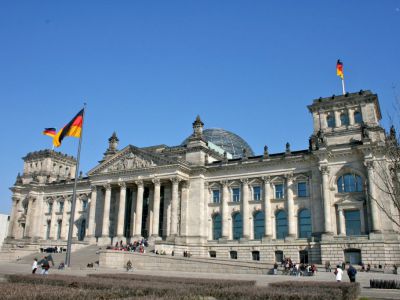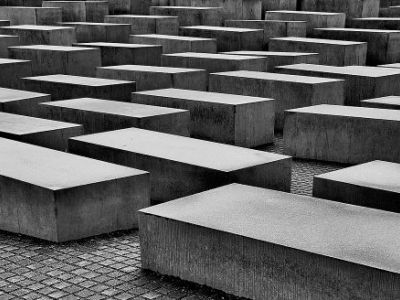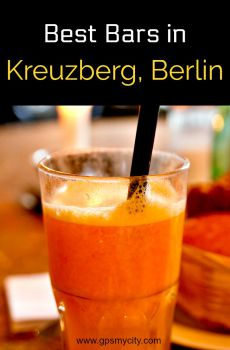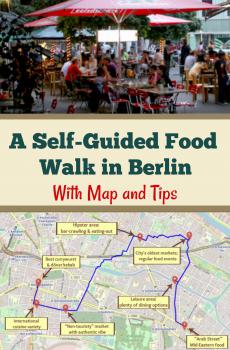
Third Reich Walking Tour (Self Guided), Berlin
The “Third Reich” and “Nazi Germany” are the common English names for Germany between 1933 and 1945, when it was a totalitarian state led by Adolf Hitler and the National Socialist German Workers’ Party. For any visitor to Berlin, the Nazi surrender that ended World War II is still a point of interest, but matching locations to those moments of history can be a challenge. On this special self-guided tour, we’ll make your quest for some key sights as easy and insightful as possible.
Begin your journey with the Reichstag – current home of the German Parliament, boasting a prime location on the banks of the Spree. Over the years, it has survived Nazi rule, wars, bombings, the country’s division and even a fire. In 1933, only a month after Hitler’s rise to power, the building was subject to a mysterious arson attack and almost destroyed by flames. The Nazis alleged that it was part of a Communist conspiracy to seize power, and shortly thereafter the entire Communist Party of Germany was arrested, thus leaving the Nazi Party unchallenged. This enabled Hitler to consolidate his power as Führer und Reichskanzler ("Leader and National Chancellor").
Make sure to also visit Goebbels’ Propaganda Ministry and Goering’s Air Force Headquarters – the largest office building in Europe at the time of its construction, described as “in the typical style of National Socialist intimidation architecture” by one writer. In these two institutions, at the height of the Third Reich, promotion occurred far more rapidly than in other departments, heavier weighting was given to party affiliation, and nepotism and corruption were rife.
By fate or coincidence, the Holocaust Memorial stands within close proximity of the Führerbunker site – where, during the last bitter days of WWII, Hitler committed suicide as a defeated oppressor. Destroyed and flooded after the war, the area now hosts an information board showing the layout of the structure.
To see an outstanding amount of WWII and post-war material, head to the Topography of Terror Museum, which rounds out the walking tour.
Begin your journey with the Reichstag – current home of the German Parliament, boasting a prime location on the banks of the Spree. Over the years, it has survived Nazi rule, wars, bombings, the country’s division and even a fire. In 1933, only a month after Hitler’s rise to power, the building was subject to a mysterious arson attack and almost destroyed by flames. The Nazis alleged that it was part of a Communist conspiracy to seize power, and shortly thereafter the entire Communist Party of Germany was arrested, thus leaving the Nazi Party unchallenged. This enabled Hitler to consolidate his power as Führer und Reichskanzler ("Leader and National Chancellor").
Make sure to also visit Goebbels’ Propaganda Ministry and Goering’s Air Force Headquarters – the largest office building in Europe at the time of its construction, described as “in the typical style of National Socialist intimidation architecture” by one writer. In these two institutions, at the height of the Third Reich, promotion occurred far more rapidly than in other departments, heavier weighting was given to party affiliation, and nepotism and corruption were rife.
By fate or coincidence, the Holocaust Memorial stands within close proximity of the Führerbunker site – where, during the last bitter days of WWII, Hitler committed suicide as a defeated oppressor. Destroyed and flooded after the war, the area now hosts an information board showing the layout of the structure.
To see an outstanding amount of WWII and post-war material, head to the Topography of Terror Museum, which rounds out the walking tour.
How it works: Download the app "GPSmyCity: Walks in 1K+ Cities" from Apple App Store or Google Play Store to your mobile phone or tablet. The app turns your mobile device into a personal tour guide and its built-in GPS navigation functions guide you from one tour stop to next. The app works offline, so no data plan is needed when traveling abroad.
Third Reich Walking Tour Map
Guide Name: Third Reich Walking Tour
Guide Location: Germany » Berlin (See other walking tours in Berlin)
Guide Type: Self-guided Walking Tour (Sightseeing)
# of Attractions: 7
Tour Duration: 2 Hour(s)
Travel Distance: 4.0 Km or 2.5 Miles
Author: clare
Sight(s) Featured in This Guide:
Guide Location: Germany » Berlin (See other walking tours in Berlin)
Guide Type: Self-guided Walking Tour (Sightseeing)
# of Attractions: 7
Tour Duration: 2 Hour(s)
Travel Distance: 4.0 Km or 2.5 Miles
Author: clare
Sight(s) Featured in This Guide:
- Reichstag (Parliament Building)
- Holocaust Denkmal (Holocaust Memorial)
- Fuhrerbunker (Hitler's Bunker)
- Propagandaministerium (Goebbels' Propaganda Ministry)
- Reichsluftfahrtministerium (Goering's Ministry of Aviation)
- Topographie des Terrors (Topography of Terror)
- Gedenkstatte Deutscher Widerstand (German Resistance Memorial Center)
1) Reichstag (Parliament Building) (must see)
One of Berlin's most iconic landmarks, the Reichstag building has a rich history and stands as a symbol of Germany's political evolution. Originally constructed between 1884 and 1894 in Neo-Renaissance style by architect Paul Wallot, it was initially intended to house the German Imperial Parliament during the German Empire. In 1916, much to the displeasure of the last German Emperor, Wilhelm II, the words "Dem deutschen Volke" ("To the German People") were prominently carved on the frieze above the entrance, and two years later, the German Republic was officially proclaimed here. However, in 1933, a catastrophic fire, allegedly set by a Dutch communist, destroyed the main hall, an event promptly exploited by Adolf Hitler to consolidate power.
Following German reunification in 1990, the Reichstag underwent a remarkable transformation under the innovative redesign by architect Norman Foster. The addition of a striking glass dome not only offers panoramic views of Berlin but also serves as a powerful symbol of transparency and openness in government. Visitors can ascend the dome and observe parliamentary proceedings below, making it a unique experience that embodies democratic principles.
The Reichstag building continues to function as the seat of the German federal parliament, the Bundestag, where elected representatives from across Germany shape the nation's legislative agenda. Sessions are open to the public, allowing visitors to witness the process firsthand. Additionally, a permanent exhibition within recalls key events in German parliamentary history, making it an engaging destination for those interested in the country's past and present.
Why You Should Visit:
Free attraction offering a unique combination of history, politics, architecture, and sweeping views of Berlin's skyline. The lift takes you up to the top floor where you can freely wander around the dome and take photos.
Tips:
Plan your visit in advance, as security measures require booking and a valid ID for entry. Consider reserving a table in the Käfer DACHGARTEN to skip queues, and remember to dress warmly otherwise, as the dome's "windows" are open, and it can get chilly up there.
Following German reunification in 1990, the Reichstag underwent a remarkable transformation under the innovative redesign by architect Norman Foster. The addition of a striking glass dome not only offers panoramic views of Berlin but also serves as a powerful symbol of transparency and openness in government. Visitors can ascend the dome and observe parliamentary proceedings below, making it a unique experience that embodies democratic principles.
The Reichstag building continues to function as the seat of the German federal parliament, the Bundestag, where elected representatives from across Germany shape the nation's legislative agenda. Sessions are open to the public, allowing visitors to witness the process firsthand. Additionally, a permanent exhibition within recalls key events in German parliamentary history, making it an engaging destination for those interested in the country's past and present.
Why You Should Visit:
Free attraction offering a unique combination of history, politics, architecture, and sweeping views of Berlin's skyline. The lift takes you up to the top floor where you can freely wander around the dome and take photos.
Tips:
Plan your visit in advance, as security measures require booking and a valid ID for entry. Consider reserving a table in the Käfer DACHGARTEN to skip queues, and remember to dress warmly otherwise, as the dome's "windows" are open, and it can get chilly up there.
2) Holocaust Denkmal (Holocaust Memorial) (must see)
Officially the Memorial to the Murdered Jews of Europe, this striking sprawl of concrete near the Brandenburg Gate serves as a powerful symbol of remembrance for the individuals who fell victim to the Nazis in concentration camps during the period from 1933 to 1945.
Unveiled to the public in 2005, it was designed by American architect Peter Eisenman and comprises 2,711 concrete slabs (or "stelae") of varying heights and sizes, arranged in a grid-like formation across a gently sloping terrain that covers some 19,000 square meters (4.7 acres). As visitors venture into this maze-like structure, the ground gradually descends, evoking a disconcerting sense of disorientation and isolation. The underlying intention is to impart the profound unease and confusion endured by the Holocaust victims. The stark and impersonal nature of the concrete slabs serves as a stark reminder of the dehumanizing and brutal aspects of the Holocaust.
Visitors are encouraged to immerse themselves in the site's evocative and symbolic design. It stands as a solemn tribute to the atrocities of the Holocaust and underscores the critical significance of preserving the memory and educating future generations about this harrowing chapter in human history. The adjacent subterranean Information Center offers a comprehensive wealth of knowledge about the Holocaust and the stories of its victims, further enhancing the memorial's role as a site for reflection and education.
Unveiled to the public in 2005, it was designed by American architect Peter Eisenman and comprises 2,711 concrete slabs (or "stelae") of varying heights and sizes, arranged in a grid-like formation across a gently sloping terrain that covers some 19,000 square meters (4.7 acres). As visitors venture into this maze-like structure, the ground gradually descends, evoking a disconcerting sense of disorientation and isolation. The underlying intention is to impart the profound unease and confusion endured by the Holocaust victims. The stark and impersonal nature of the concrete slabs serves as a stark reminder of the dehumanizing and brutal aspects of the Holocaust.
Visitors are encouraged to immerse themselves in the site's evocative and symbolic design. It stands as a solemn tribute to the atrocities of the Holocaust and underscores the critical significance of preserving the memory and educating future generations about this harrowing chapter in human history. The adjacent subterranean Information Center offers a comprehensive wealth of knowledge about the Holocaust and the stories of its victims, further enhancing the memorial's role as a site for reflection and education.
3) Fuhrerbunker (Hitler's Bunker)
Once found beneath the garden of the New Reich Chancellery in Berlin, the Führerbunker, a network of fortified concrete chambers, served as the nerve center of the Nazi regime until the final days of World War II in Europe. Having taken up residence in the shelter on 16 January 1945, Hitler celebrated his 56th birthday on April 20 and married Eva Braun 9 there days later, before they both committed suicide on April 30: he with a revolver, she by poison. Allegedly, their lifeless bodies were carried to the Chancellery courtyard and drenched in 200 liters of gasoline, with Nazi supporters saluting as the corpses turned to ashes. Meanwhile, as the Soviet forces raised the red flag atop the Reichstag building, nearly all of the 800 or so bunker occupants made a desperate attempt to escape via railway tunnels in northern Berlin. About a hundred of them managed to succeed, while the remainder either met their demise or were captured.
In the post-war period, both the old and new Chancellery structures were razed by Soviet forces. Despite some attempts at demolition, the subterranean complex remained mostly untouched until 1988–89 when sections of it were uncovered (and mostly destroyed) during the neighborhood's redevelopment as a residential area. The Führerbunker site remained unmarked until 2006 when a small plaque was installed, providing detailed information and a schematic diagram. The bunker's emergency exit point, which once led to the Chancellery gardens, was occupied by a parking lot.
In the post-war period, both the old and new Chancellery structures were razed by Soviet forces. Despite some attempts at demolition, the subterranean complex remained mostly untouched until 1988–89 when sections of it were uncovered (and mostly destroyed) during the neighborhood's redevelopment as a residential area. The Führerbunker site remained unmarked until 2006 when a small plaque was installed, providing detailed information and a schematic diagram. The bunker's emergency exit point, which once led to the Chancellery gardens, was occupied by a parking lot.
4) Propagandaministerium (Goebbels' Propaganda Ministry)
Shortly after Adolf Hitler assumed the position of Reich Chancellor of Germany in January 1933, Joseph Goebbels, chief propagandist of the Nazi party, was rewarded for his part in helping the Nazis seize power. He was appointed as the Reich Minister of Public Enlightenment and Propaganda, holding a seat in the Cabinet. The role of the new ministry, which took over palatial accommodation in the 18th-century Leopold Palace, just across from Hitler's offices in the Reich Chancellery, was to centralize Nazi control of all aspects of German cultural and intellectual life, news media, literature, visual arts, filmmaking, theatre, music, and broadcasting. An unspoken aim was to convey to the world that the Nazi Party enjoyed full and enthusiastic support from the entire population.
A significant focus of propaganda efforts centered on Hitler himself, who was glorified as a heroic and infallible leader and became the focus of a cult of personality. Some of this adulation was spontaneous, while other aspects were carefully orchestrated as part of Goebbels' propaganda machinery. An example of the latter can be seen in the 1934 Nuremberg Rally, which marked one of the first carefully choreographed events where Hitler's actions were staged for the camera. This rally was the subject of the film "Triumph of the Will", one of several Nazi propaganda films directed by Leni Riefenstahl.
With nationalist socialist architecture expressed in the building's structure and façade design, the Propaganda Ministry grew steadily from five departments and 350 employees in 1933 to seventeen departments and 2,000 employees by 1939. World War II witnessed a significantly heightened level of propaganda, particularly through the emerging media of film, newsreels, and radio broadcasting. Thanks to practical experience and the scientific study of propaganda in Europe and the United States, propaganda efforts were meticulously planned, giving rise to a new era of psychological warfare.
A significant focus of propaganda efforts centered on Hitler himself, who was glorified as a heroic and infallible leader and became the focus of a cult of personality. Some of this adulation was spontaneous, while other aspects were carefully orchestrated as part of Goebbels' propaganda machinery. An example of the latter can be seen in the 1934 Nuremberg Rally, which marked one of the first carefully choreographed events where Hitler's actions were staged for the camera. This rally was the subject of the film "Triumph of the Will", one of several Nazi propaganda films directed by Leni Riefenstahl.
With nationalist socialist architecture expressed in the building's structure and façade design, the Propaganda Ministry grew steadily from five departments and 350 employees in 1933 to seventeen departments and 2,000 employees by 1939. World War II witnessed a significantly heightened level of propaganda, particularly through the emerging media of film, newsreels, and radio broadcasting. Thanks to practical experience and the scientific study of propaganda in Europe and the United States, propaganda efforts were meticulously planned, giving rise to a new era of psychological warfare.
5) Reichsluftfahrtministerium (Goering's Ministry of Aviation)
Hermann Goering's air force headquarters, known as the Ministry of Aviation, stood as the largest office building in Europe at the time of its construction. Described as a prime example of National Socialist intimidation architecture by a writer, this imposing edifice had seven stories, a sprawling floor area of 112,000 square meters (1,210,000 square feet), 2,800 rooms, a network of 7 kilometers (4.3 miles) of corridors, over 4,000 windows, 17 stairways, and used stone sourced from no fewer than 50 quarries. It accommodated the expanding bureaucracy of the Luftwaffe, along with Germany's civil aviation authority, which also had its offices there, yet it took a mere 18 months to build, with laborers toiling in double shifts and even on Sundays. The first 1,000 rooms were completed in just eight months, with a total workforce of 4,000 bureaucrats and their secretaries occupying the premises upon completion.
Remarkably, the building was one of the few in central Berlin to escape serious damage during the Allied bombing offensive in 1944-45. Following World War II, it served as the headquarters for the Soviet military administration until 1948, and from 1947 to 1949, it housed the German Economic Commission, which functioned as the principal administrative body in the Soviet Occupation Zone.
Between 1950 and 1952, an extraordinary 18-meter (59-foot) long mural was crafted along Leipziger Strasse. Set back behind pillars and made out of Meissen porcelain tiles, it was created by the German painter and commercial artist Max Lingner together with 14 artisans, depicting the Socialist ideal of contented East Germans facing a bright future as one united and joyous family.
From 1991 to 1995, after German reunification, the former Ministry housed the Trust Establishment ("Treuhand"), responsible for privatizing enterprises previously operated by the East German government. Its chairman lost his life to Red Army Faction terrorists in 1991, and the building was renamed the Detlev-Rohwedder-Haus in his honor. Starting from 1990, the office of the German Finance Ministry was also located here, and since 1999, following a vast refurbishment, the structure has continued to serve as the Ministry's headquarters.
Remarkably, the building was one of the few in central Berlin to escape serious damage during the Allied bombing offensive in 1944-45. Following World War II, it served as the headquarters for the Soviet military administration until 1948, and from 1947 to 1949, it housed the German Economic Commission, which functioned as the principal administrative body in the Soviet Occupation Zone.
Between 1950 and 1952, an extraordinary 18-meter (59-foot) long mural was crafted along Leipziger Strasse. Set back behind pillars and made out of Meissen porcelain tiles, it was created by the German painter and commercial artist Max Lingner together with 14 artisans, depicting the Socialist ideal of contented East Germans facing a bright future as one united and joyous family.
From 1991 to 1995, after German reunification, the former Ministry housed the Trust Establishment ("Treuhand"), responsible for privatizing enterprises previously operated by the East German government. Its chairman lost his life to Red Army Faction terrorists in 1991, and the building was renamed the Detlev-Rohwedder-Haus in his honor. Starting from 1990, the office of the German Finance Ministry was also located here, and since 1999, following a vast refurbishment, the structure has continued to serve as the Ministry's headquarters.
6) Topographie des Terrors (Topography of Terror) (must see)
Charting the history of persecution in Germany and the rise of Nazi/SS organizations, Topography of Terror stands as a chilling testament to one of the most brutal interrogation agencies in history, rivaling even the Inquisition. Although the buildings that once housed the Gestapo and SS headquarters were largely obliterated by Allied bombing in early 1945 and subsequently razed after the war, the outer wall of this site managed to endure, now serving as the backdrop for an outdoor chronological exhibition featuring photographs and documents. Adjacent to this, visitors can explore the excavated basement of a Gestapo headquarters from the Third Reich era.
A must-see for anyone seeking to understand the dark history of the Nazi party, the indoor museum is thoughtfully housed in a modern and well-lit building, complete with a café and free restrooms. While the content can be emotionally challenging to absorb, it is presented with clarity and objectivity, organized into distinct themes that encompass various countries and groups of people. The curation excels in its blend of photographs, letters, documents, and audiovisual materials, which collectively narrate a deeply troubling story in a sensitive but unflinching manner. Before delving into the exhibits, it is advisable to store coats and bags in the provided lockers and embark on the highly informative self-guided audio tour.
Tip:
When exploring the outdoor memorial storyboard, start from the left side, and if visiting in winter, dress warmly as it can be quite cold. Additionally, consider joining the free English tour at 3:30pm on Sundays for a quicker overview without delving into every panel.
A must-see for anyone seeking to understand the dark history of the Nazi party, the indoor museum is thoughtfully housed in a modern and well-lit building, complete with a café and free restrooms. While the content can be emotionally challenging to absorb, it is presented with clarity and objectivity, organized into distinct themes that encompass various countries and groups of people. The curation excels in its blend of photographs, letters, documents, and audiovisual materials, which collectively narrate a deeply troubling story in a sensitive but unflinching manner. Before delving into the exhibits, it is advisable to store coats and bags in the provided lockers and embark on the highly informative self-guided audio tour.
Tip:
When exploring the outdoor memorial storyboard, start from the left side, and if visiting in winter, dress warmly as it can be quite cold. Additionally, consider joining the free English tour at 3:30pm on Sundays for a quicker overview without delving into every panel.
7) Gedenkstatte Deutscher Widerstand (German Resistance Memorial Center)
Located in Berlin's Mitte district, the German Resistance Memorial Center serves as a poignant reminder of the daring coup attempt that unfolded on July 20, 1944, against the oppressive National Socialist regime. This pivotal event, known as the "20 July Plot" or "Operation Valkyrie", was led by a group of German officers and civilians during World War II, whose primary objective was to assassinate Adolf Hitler and overthrow the tyrannical Nazi regime ruling Germany, in the hopes of creating an opportunity to establish a new government that would end the war and prevent further devastation caused by regime.
Colonel Claus von Stauffenberg played a central role in this audacious plot. His deep disillusionment with Hitler's ideology and the heinous actions committed by the Nazis fueled his determination to take action. On July 20, 1944, von Stauffenberg, alongside other high-ranking officers, attended a military conference at the Wolf's Lair, Hitler's headquarters in East Prussia. Concealing a bomb inside a briefcase, he placed it under a table near Hitler during the meeting. Despite causing casualties and chaos, the explosion only resulted in minor injuries to the dictator, and he survived the assassination attempt; however, the plot's subsequent exposure triggered a swift and brutal crackdown on the conspirators. Many were arrested, subjected to interrogations, and executed in the ensuing days and weeks.
Today, visitors to the Memorial Center can explore the historic rooms and courtyards where key members of the German resistance operated and where the plot was organized. By showcasing the bravery and determination of these individuals, the institution encourages reflection, education, and a deeper understanding of the intricate history of resistance against totalitarian regimes.
Colonel Claus von Stauffenberg played a central role in this audacious plot. His deep disillusionment with Hitler's ideology and the heinous actions committed by the Nazis fueled his determination to take action. On July 20, 1944, von Stauffenberg, alongside other high-ranking officers, attended a military conference at the Wolf's Lair, Hitler's headquarters in East Prussia. Concealing a bomb inside a briefcase, he placed it under a table near Hitler during the meeting. Despite causing casualties and chaos, the explosion only resulted in minor injuries to the dictator, and he survived the assassination attempt; however, the plot's subsequent exposure triggered a swift and brutal crackdown on the conspirators. Many were arrested, subjected to interrogations, and executed in the ensuing days and weeks.
Today, visitors to the Memorial Center can explore the historic rooms and courtyards where key members of the German resistance operated and where the plot was organized. By showcasing the bravery and determination of these individuals, the institution encourages reflection, education, and a deeper understanding of the intricate history of resistance against totalitarian regimes.
Walking Tours in Berlin, Germany
Create Your Own Walk in Berlin
Creating your own self-guided walk in Berlin is easy and fun. Choose the city attractions that you want to see and a walk route map will be created just for you. You can even set your hotel as the start point of the walk.
Alexanderplatz Walking Tour
One of Berlin’s cosmopolitan hearts, Alexanderplatz (or Alexander Square) is a true hive of activity. There is always something going on here: Christmas markets, Easter fairs, buskers, performances, Oktoberfest, and the list is countless. Easily accessible, with lots of transport connections and all manner of drink and food outlets, it’s a great place to hang around, take photos, and enjoy... view more
Tour Duration: 1 Hour(s)
Travel Distance: 1.6 Km or 1 Miles
Tour Duration: 1 Hour(s)
Travel Distance: 1.6 Km or 1 Miles
Berlin Introduction Walking Tour
Known for its turbulent past, today's German capital is a global city for international affairs, creative industries, popular media and diverse cultural tourism. The first written records of settlements in the area of present-day Berlin date from the late 12th century, when the region came under German rule as part of the Margraviate of Brandenburg, founded by Albert the Bear in 1157. Berlin... view more
Tour Duration: 2 Hour(s)
Travel Distance: 4.0 Km or 2.5 Miles
Tour Duration: 2 Hour(s)
Travel Distance: 4.0 Km or 2.5 Miles
Tiergarten Walking Tour
Known for the huge park of the same name, which once was a royal hunting ground, the central district of Tiergarten (German for “Animal Garden”) is home to the Berlin Zoo, the Victory Column with its winged statue and the lively, lakeside Café am Neuen See.
Begin your exploration at Postdamer Platz, the historic central square of Berlin, once regarded in the same way as Piccadilly Circus... view more
Tour Duration: 2 Hour(s)
Travel Distance: 3.4 Km or 2.1 Miles
Begin your exploration at Postdamer Platz, the historic central square of Berlin, once regarded in the same way as Piccadilly Circus... view more
Tour Duration: 2 Hour(s)
Travel Distance: 3.4 Km or 2.1 Miles
Museum Island Walking Tour
One of Berlin’s most visited attractions, the Museum Island ("Museumsinsel") complex was established by order of King Frederick William IV of Prussia in 1841 and houses several world-famous museums kept in close vicinity of each other. The island itself is spectacular for a walk, with wonderful architecture, statues, gardens and trees, so enjoy the atmosphere and make at least a day... view more
Tour Duration: 1 Hour(s)
Travel Distance: 1.2 Km or 0.7 Miles
Tour Duration: 1 Hour(s)
Travel Distance: 1.2 Km or 0.7 Miles
Berlin Food Walking Tour
While Berlin may not be considered a typical foodie destination yet, recent years saw a growing number of decent places to eat, serving both German and international cuisine. At some point, the city has even earned itself the title of a vegetarian capital of the world, contrary to what one may have expected. Amid all this renaissance in creativity and culture, coupled with the influx of the... view more
Tour Duration: 1 Hour(s)
Travel Distance: 1.4 Km or 0.9 Miles
Tour Duration: 1 Hour(s)
Travel Distance: 1.4 Km or 0.9 Miles
Useful Travel Guides for Planning Your Trip
Best Bars in Kreuzberg, Berlin
Kreuzberg and "Kreuzkölln" - the area where Kreuzberg and Neukölln meet, mostly along the canal in east Kreuzberg and north of Sonnenallée in Neukölln - has a constantly and rapidly evolving bar culture that makes it one of the trendiest alternative evening and nightlife spots in...
A Self-Guided Food Walk in Berlin
Repeatedly scarred throughout its long and often depressing past, today's Berlin has made a comeback as a major bohemian hub which lures artists and creatively-minded folk from all over the globe in their droves. It may well not be considered a typical foodie destination yet, but in recent...
Best Food in Kreuzberg, Berlin
Kreuzberg is known for having great cheap, street food, particularly of the Middle Eastern variety. On almost every corner you can find a kebab or falafel shop, although the trick is knowing which to choose! While you can typically get a good, tasty wrap for €2.50-4, the quality, quantity and...
Best Cafes in Kreuzberg, Berlin
Traditionally, you may expect the cafes around Kottbusser Tor and throughout Kreuzberg to be dominated by ethnic Turks, particularly men, in rooms that do much to resemble the cafes of Istanbul.
More recently, however, the ethnically Turkish and Arab communities that have typically inhabited...
Berlin Mementos: 18 Souvenir Shopping Ideas for Travelers
Too many people and for very different reasons strove to set their foot in Berlin over the course of the 20th century. Today, the city proves just as luring a destination for numerous travelers who want to come and enjoy themselves in this fascinating European capital and, perhaps, bring home...
Best Cafés and Coffee Houses of Berlin
Cafes have a certain refinery and elegance that pubs lack; there is a mellowness that is rarely found in bars and clubs, and an ease and tranquillity that is not to be found in restaurants with their steaming kitchens, heavy plates, clattering cutlery, constant complaints and corrections and,...
The Most Popular Cities
/ view all


















